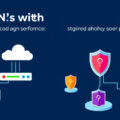In the realm of computer networking, maintaining high performance and reliability is crucial for any organization. One effective method to achieve this is through link aggregation. This article will explore the features and advantages of link aggregation, as well as the Link Aggregation Control Protocol (LACP), to help you enhance your network infrastructure.
What is Link Aggregation?
Link aggregation is the process of combining multiple physical network connections into a single logical link. This technique allows multiple Ethernet links to work together to increase bandwidth and provide redundancy. The underlying concept is simple: by bundling connections together, network devices can share the load, thereby improving data transmission rates and enhancing reliability.
Key Terminology
- Link Aggregation Group (LAG): The collection of physical links that are combined to form a single logical link.
- Traffic Load Balancing: The method of distributing network traffic evenly across the aggregated links to optimize performance and prevent any single link from becoming a bottleneck.
- Link Aggregation Control Protocol (LACP): A standardized protocol defined by IEEE 802.1AX, which manages the dynamic establishment of LAGs and ensures proper configuration and monitoring of the aggregated links.

Advantages of Link Aggregation
-
Increased Bandwidth: By combining multiple links, you can significantly increase the available bandwidth without the need for new cables or hardware. This is particularly beneficial in environments with high data traffic demands.
-
Enhanced Reliability: If one link in a LAG fails, traffic is automatically redistributed to the remaining links. This seamless failover mechanism ensures that network service remains uninterrupted, boosting overall reliability.
-
Better Resource Utilization: Link aggregation allows for more efficient use of existing network resources. By balancing traffic across multiple links, it maximizes throughput and minimizes idle capacity.
-
Cost-Effectiveness: Instead of investing in costly infrastructure upgrades to handle increasing bandwidth demands, organizations can leverage existing hardware through link aggregation to scale their networks affordably.
How Link Aggregation Works
Link aggregation operates on the premise of sending Ethernet frames across multiple channels rather than a single connection, but it does not divide the packets themselves across these links. Instead, specific packets from a communication session will follow the same link, ensuring orderly transmission and minimizing packet loss.
Scheduling Algorithms
The efficiency of a LAG is heavily influenced by the scheduling algorithm used. Common algorithms include:
- MAC Address Hashing: Traffic is divided based on the source and destination MAC addresses. While effective in many scenarios, it may not be optimal when traffic primarily flows between two specific devices.
- IP Address Hashing: This approach accounts for the source and destination IP addresses, often yielding better load balancing in environments where two devices exchange the bulk of the traffic.
Organizations can customize their LAG setups to suit their specific network needs, choosing from several algorithms based on their data patterns.
The Role of Link Aggregation Control Protocol (LACP)
LACP simplifies the management of link aggregations by allowing devices to negotiate link settings dynamically. It plays a crucial role by ensuring that:
- Both ends of a link are properly configured for aggregation.
- Links that encounter issues (e.g., physical disconnections) are automatically removed from the aggregation group.
- Adjustments can be made in real-time to maintain network performance.
With LACP, network administrators can avoid common pitfalls, such as misconfigurations that can lead to network downtime.
Conclusion
Link aggregation is an invaluable feature for enhancing network performance and reliability in today’s data-driven environments. By utilizing the Link Aggregation Control Protocol and understanding the benefits of aggregation, organizations can not only improve bandwidth but also streamline network management. As you consider implementing link aggregation in your infrastructure, keep in mind the importance of proper setup and configuration to fully leverage its capabilities.
By investing in efficient network techniques like link aggregation, organizations can ensure that they are well-equipped to handle current and future connectivity needs.



